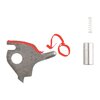243winxb
Member
Installed a Power Custom Hammer Nose in my S&W M28-2. It was not a drop in item. It does come with instruction, spring, rivet & Hammer Nose.
The top of the Hammer Nose had to be trimmed. It hit the frame & was above the profile of the hammer. The tip was not round. It stuck in the hole in the frame. Had to be rounded with a file.
The spring is smaller & lighter then factory. The Rivet is thicker then factory.
 Protrusion measured around .048" Test fired 10 slow, 10 double action. Worked well.
Protrusion measured around .048" Test fired 10 slow, 10 double action. Worked well.
The top of the Hammer Nose had to be trimmed. It hit the frame & was above the profile of the hammer. The tip was not round. It stuck in the hole in the frame. Had to be rounded with a file.
The spring is smaller & lighter then factory. The Rivet is thicker then factory.
 Protrusion measured around .048" Test fired 10 slow, 10 double action. Worked well.
Protrusion measured around .048" Test fired 10 slow, 10 double action. Worked well.
